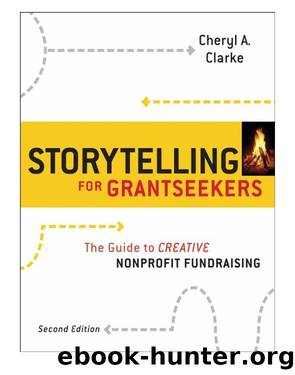Storytelling for Grantseekers by Cheryl A. Clarke

Author:Cheryl A. Clarke [Clarke, Cheryl A.]
Language: eng
Format: epub
Publisher: Wiley
Published: 2010-05-11T05:00:00+00:00
Each of these incidents would be a gripping moment in a story because something significant, something climactic, is about to happen. Something will change the lives of the main characters forever. What happens next? What will change? The job of the storyteller is to provide the answers.
Similarly, a proposal story isn’t finished until it too has reached a climactic moment and the reader’s questions about what will happen next have been answered.
THE GOALS AND OBJECTIVES SECTION
The problem or needs section of a proposal describes the unmet needs of or problems faced by the story’s main characters, the agency’s clients. The hero agency must intervene and provide effective services. By doing so, the societal problem can be addressed. The unmet need can be fulfilled. The lives of the agency’s clients can be improved.
What follows the needs section in the proposal narrative is a discussion about what changes are possible if the nonprofit agency secures the necessary grant funding, allowing it to respond to the problem and deliver vital services. Because such change is prospective, this section is also prospective. When writing this section of the proposal, grantseekers are like sci-fi writers who envision the future. Of course, there is one critical difference: whereas sci-fi writers present fantasy, grantwriters discuss what is realistic and feasible.
To understand this concept, it may help to think in visual terms. Take a mental snapshot of the community where your nonprofit agency does its work today, at this very moment. What is the problem or unmet need that your agency addresses? Who are the people served by your agency? What more could your agency do if it had additional funds?
Now imagine taking a second mental photograph of this same community at the end of the projected grant period. Compare it with the earlier snapshot. What’s different? How has the need been met? How have the clients been served? Most important, how have the lives of your agency’s clients been altered and positively changed? You should “see” a noticeable difference between these two mental snapshots. (If you don’t, then perhaps your agency’s services aren’t as effective as they could be.)
How the community and your story’s main characters (your agency’s clients) will have changed is portrayed in the goals and objectives section of a grant proposal. The challenge in writing this portion of your proposal story is to vividly and accurately describe to the reader the change(s) that will take place, as represented by those two mental snapshots. The change that occurs helps reduce or resolve the conflict (the problem or need).
Readers appreciate a story that has a believable, satisfying resolution. Program officers and others reviewing grant proposals do too. The validity of your request hinges on whether the resolution of the conflict rings true. If it doesn’t, the story falls flat and short of the mark, no matter how well it is written or told.
Download
This site does not store any files on its server. We only index and link to content provided by other sites. Please contact the content providers to delete copyright contents if any and email us, we'll remove relevant links or contents immediately.
| Consulting | Entrepreneurship |
| Franchises | Home Based |
| Marketing | New Business Enterprises |
| Nonprofit Organizations & Charities |
Pioneering Portfolio Management by David F. Swensen(5619)
Zero to One by Peter Thiel(4839)
Man-made Catastrophes and Risk Information Concealment by Dmitry Chernov & Didier Sornette(4751)
The Motivation Myth by Jeff Haden(4540)
The Miracle Morning by Hal Elrod(3925)
Elon Musk by Ashlee Vance(3463)
The Art of Persistence: Stop Quitting, Ignore Shiny Objects and Climb Your Way to Success by Michal Stawicki(3370)
Unlabel: Selling You Without Selling Out by Marc Ecko(2996)
Urban Outlaw by Magnus Walker(2953)
Delivering Happiness by Tony Hsieh(2930)
Purple Cow by Seth Godin(2708)
Mastering Bitcoin: Programming the Open Blockchain by Andreas M. Antonopoulos(2523)
The Content Trap by Bharat Anand(2499)
The Marketing Plan Handbook: Develop Big-Picture Marketing Plans for Pennies on the Dollar by Robert W. Bly(2422)
The Power of Broke by Daymond John(2383)
The Airbnb Story by Leigh Gallagher(2380)
Applied Empathy by Michael Ventura(2335)
Radical Candor by Kim Scott(2231)
Keep Going by Austin Kleon(2174)
